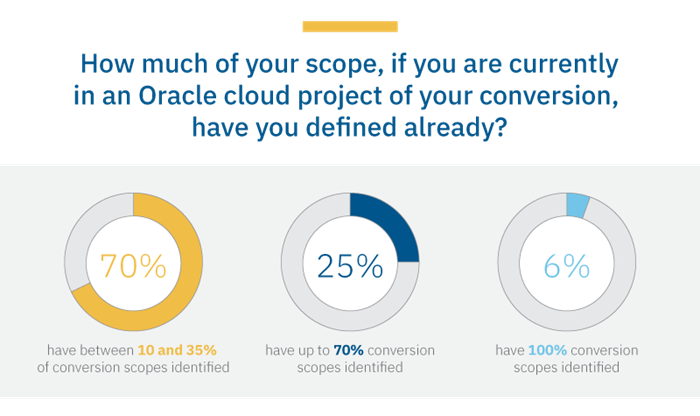In Huron’s webinar with HEUG, an industry expert with more than two decades of Oracle application experience offers five lessons learned for cloud success.
Huron, in partnership with the Higher Education User Group (HEUG), led a four-part webinar series to share best practices and methodologies universities should consider when moving to the cloud. HEUG is an Oracle user group for higher education technology professions that facilitates the sharing of ideas, information and experiences among its members.
Part three of the webinar series offers five technical planning and strategy recommendations to ensure a successful cloud implementation. Robert Stojkovic, a director at Huron, specializes in development strategy, technical project management and integration. He joined Huron’s webinar with HEUG, Technical Planning and Strategy, where he discussed five tips he learned from assisting institutions with cloud implementation.
Tip One: Determine Scope Early
“Determine scope as early as possible,” Stojkovic said. Determining scope at the forefront of the project includes listing the anticipated level of effort, timelines and required resources. It is essentially the methods and resources for implementation and provides a way for the entire team to stay aligned and accountable for their portion(s) of the project.
In a poll taken during the webinar, only 6 percent of participants had their conversion scopes completely identified. The majority of participants only had 10 and 35 percent of their conversion scopes identified.
Projects that do not determine scope early can encounter issues. Often on a project, individuals will discover a new module they can use that they had not previously considered. These new modules, however, require converted data. Without defining this in scope, it becomes more difficult to prepare all the converted data that the project requires. "If organizations determine scope early, then they know how to manage those blips along the way more easily," he said.
Tip Two: Define Cycles
"Defining cycles allows organizations to plan for refreshes, not only of the Oracle Cloud but also of the source system," Stojkovic said. This definition helps organizations plan and keep different processes, systems and teams in sync.
Determining scope at the forefront of the project includes listing the anticipated level of effort, timelines and required resources.
Stojkovic recommends corresponding refresh cycles with test cycles. “This is very beneficial to organizations,” he said. “If organizations plan testing cycles appropriately, regularly occurring updates to the application should fall within test cycles, so regression and standard implementation testing through CRP, SIT and UAT cycles can happen simultaneously.”
There are a couple of considerations regarding instant management for refreshes:
Blackout periods: When organizations cannot conduct a refresh; this is usually during patching (upgrade) periods.
Time down for refreshes: Typically, the snapshot an institution is working from is taken within the first 30 minutes, so work in that instance that was the source for the refresh may continue after that period.
Tip Three: Standardize Framework
Standardization is essential to keep teams and processes aligned. “If it's standardized, people will be able to understand it,” Stojkovic said. “They feel comfortable that they know how the conversions are happening and how the data mapping relates to those conversions.”
Plus, standardization aides with future needs – mainly audits. This came in handy on one project that Stojkovic worked on. They converted the organization’s general ledger with a chart of accounts conversion for the balances. The team created a staging table, where they had both the old and new chart field strings, which enabled them to show where the balance went from the old to the new.
“Because we had this standardized framework of the staging tables that we could refer back to, the organization was able to explain to the auditor exactly how the balances moved over and what that process was,” he said. “They didn't need consultants because they understood their framework and how things worked.”
Tip Four: Leverage All Available Tools
There are very powerful tools available to organizations, and those that leverage all of them in a complete tech stack ecosystem are set up for cloud implementation success.
“You cannot just use Structured Query Language (SQL) script to insert data into the Cloud,” Stojkovic said. “There are file-based imports for the scheduled processes, desktop imports, SOAP services and Representational State Transfer (REST) services which organizations can orchestrate to work together through the application programming interfaces (APIs).”
Tip Five: Constantly Communicate with Functional Team
“The last very important piece is constant communication with the functional team,” Stojkovic said. “As teams go through the business process transformations and refine their business if they work in isolation on the tech side, organizations may have errors because data isn't mapping appropriately."
Stojkovic recommends collecting input from the change management, project management and technology teams. Using that feedback, organizations can plan and make necessary adjustments, and then communicate how the data will look and be used in the new system.
Workgroups also foster cross-functional team collaboration, a tactic discussed in many other webinars in this series. “That same concept has to happen when building and planning out conversions in integrations,” Stojkovic said.
Workgroups should comprise more than just technical individuals and should include change management, project management and functional team members. Those are the individuals who will be educating other employees, so creating this cross-departmental collaboration supports cloud implementation success.

